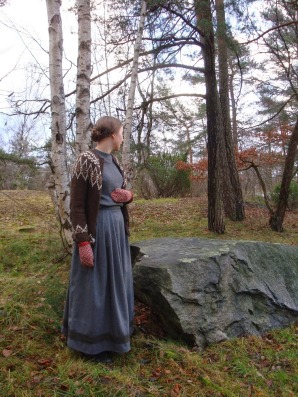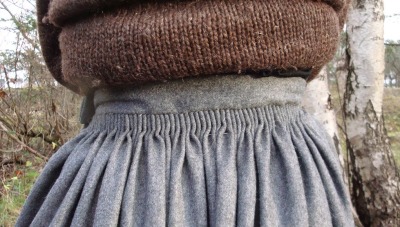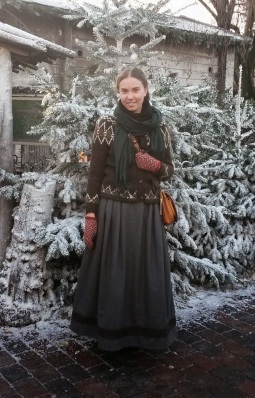Vintrar här brukar ju vara rätt kalla och med tanke på det så bestämde jag att jag behövde en ny kjol till vintern. En lång yllekjol för att hålla mig varm. Både materialet och längden skulle hjälpa till att hålla mig varm. Jag älskar mina historiska kläder och hade verkligen tyckt om att kunna använda dem varje dag, men mina medeltidskläder känns lite väl off. Sen jag har börjat sy en 1840-talsgarderob så har jag tittat på många bevarade kläder från Blekinge, där jag kommer från, och har tänkt ganska länge att jag ska sy en kjol som de som finns bevarade. I detta Pinterest-album har jag sparat all min inspiration.
Winters in Sweden are usually cold, and with that in mind I decided that I needed a new skirt for winter. A long, woolen skirt to keep me warm. Both the lenght and the material would keep me warm. I do love my historical clothing and I would love to wear them in a sort of more everyday context, but my medieval warderobe is a bit to “special” to wear other than in the forest or at events. Since I’ve started to make a warderobe for the 1840’s I’ve been looking at lots of extant clothing from my home county here in Sweden and have been wanting to sew a skirt like those I’ve seen. On this Pinterest-board I’ve saved my inspiration.
 |
| A skirt from Hjortsberga, Blekinge, 1830-1860. Woolmix tabby. Warp in linen and weft in wool. Nordiska Museet NM.0112174 |
De bevarade kjolarna är ofta i halvylle – antingen linne eller bomull i varp och ylle som inslag – och har ett sidenband påsytt längs fållen. Väldigt fint. Jag tittade i min tyghög och hittade ett grått ylle som jag insåg skulle passa utmärkt till min idé. Tillsammans med ett mörkare grått ylle som jag fick över från min Herjolfsneshätta, så skulle det bli väldigt fint! Det mörkare yllet skulle få ersätta sidenbandet och jag fick skarva det på väldigt många ställen för att få ihop till kjolen, men jag tycker slutresultatet blev så fint att det verkligen var värt det!
They are normally in a wool/cotton blended tabby – one for the warp and one for the weft – and has a silk ribbon sewn on to the bottom hem. Very pretty. I looked into my stash and found a grey wool twill that would suit perfectly for my idea. Together with some dark grey left over scraps from my Herjolfsnes hood, which would be the trimming, it would make a very pretty skirt. I had to piece the dark grey trim a lot since it was in small pieces, but I think that the finished result is so pretty that it was totally worth it.
 |
| Me in my favourite material – wool! |
 |
| Worn over my petticoat from HSF #19 – Inspiration |
Även om tanken var att det skulle bli en vardagskjol så ville jag handsy den. Jag är alldeles för lat för att plocka fram symaskinen och resultatet blev så mycket bättre än om jag hade sytt på maskin. Jag ville kunna använda kjolen till reenactment med så att sy på maskin kom aldrig ens på tanken. Måtten är tagna från bevarade kjolar och det är även sömnadsteknikerna. Ryggen är sydd med stripade rynkor (osäker på termen där faktiskt) och framsidan har ett slätt stycke samt är veckad. Den stängs på vänster sida med hyskor och hakar.
Even though it is supposed to be an everyday skirt I wanted to hand sew it. I’m to lazy to take out the sewing machine and the result is so much more delicate and pretty than if I’d used the machine. I wanted to be able to wear the skirt at reenactment events as well so it was really never a question. The measurments are taken from extant skirts and so are most of the sewing techniques. The back is cartridge pleated, the immediate front is flat and the front sides are knife pleated. It closes at the sides with hooks and eyes.
 |
| The front – knife pleats and flat front |
 |
| The back – cartridge pleats |
Jag gick ifrån originalen på två ställen. För det första hoppade jag över att sy in ett linnestycke längst fram. Det sägs att “den lappen skulle alltid finnas på kjolen oavsett om tyget räckte till eller ej, den kallades för djäknalappen” och jag vet ärligt inte varför. Förklädet som man alltid hade på sig täckte i alla fall det kontrasterande stycket. Det andra jag gjorde annorlunda var att jag sydde på ylletyg istället för ett sidenband – det vet jag inte om det gjordes.
I stepped away from the originals in two things. Firstly I skipped the part in front which is in a compleatly different fabric. It is said that every skirt should have a piece like that – for reasons I don’t know – and it wouldn’t be seen since the apron you always wore would cover it. The other thing is that I used a wool fabric as trim and not silk ribbon. I don’t know if that was done.
Första gången jag använde kjolen var på min födelsedag, på Lucia. Det var ungefär 5 grader ute och jag var varmare än jag någonsin varit förut! Eller ja, mina ben var framförallt mycket varmare. Under kjolen hade jag min bomullsunderkjol och yllestrumpor. Helt klart nöjd!
I first wore the skirt at my birthday, the 13th of December. It was about 5 degrees Celsius and I was warm all day. Under the skirt I wore my petticoat and wool stockings. I’m so happy with it!
 |
| Since it was no snow here I borrowed the setting with the fake snow. This is how I looked all day. |
What the item is: A woolen skirt
The Challenge: #23 – Modern history
Fabric: A grey, fulled wool. I used 2*1,5 meters
Pattern: None
Year: Aiming for around the 1840s
Notions: It is sewn with waxed linen thread, the trim is another wool fabric, sewn down with threads from its own warp, hooks and eyes in brass.
How historically accurate is it? It’s OK, I guess. Apart from the square of linen fabric in front that a chose to skip and that the trim is made of wool fabric instead of silk ribbon, I’d say its really good. It is sewn with period techniques and in oeriod materials.
Hours to complete: I’m always bad at keeping track of this. Maybe 15?
First worn: On my birthday, December 13th. 🙂
Total cost: The fabric cost 150 SEK/meter and the notions came from my stash, but say 20 SEK for those, so in total that would be 320 SEK ($42,40, €34,14, £23,98).

Den blev jättefin! Helt ljuvlig.
LikeLike
Tack! ^^
LikeLike
Så supersnygg!!!
LikeLike
Hihi, tack!! Jag har nog aldrig varit så varm om låren förr.
LikeLike
Jättefin! Och grattis i efterskott!
LikeLike
Tack! 😀
LikeLike
Som släktforskare är jag intresserad av det som du håller på med – historiska kläder. Försöker forska på hur allmogen var klädd på 1700-talet, jag tror att det inte skiljer så mycket på kläderna från 1700-1800-talen. Man kan se i bouppteckningar vad deras garderob bestod av, svårare att se hur kläderna såg ut. Din kjol känns helt rätt!
LikeLike
Tack!
Ja, i vissa fall är allmogens kläder betydligt mer intressanta just för att de inte är lika dokumenterade eller finns bevarade i samma mängder. Det blir större mystik kring dem. 🙂
LikeLike